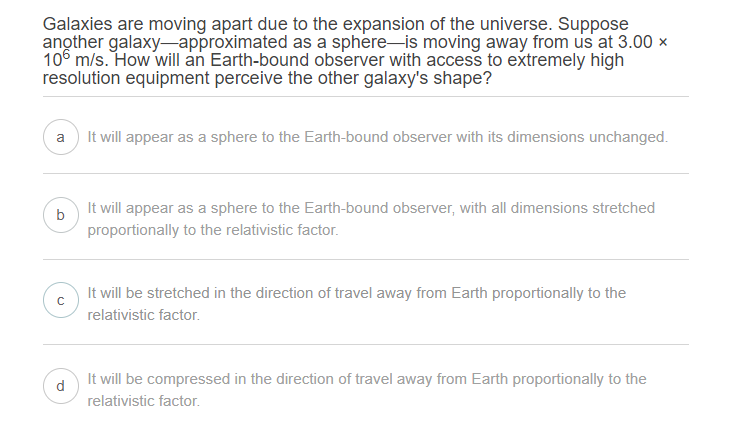Galaxies are moving apart due to the expansion of the universe. Suppose another galaxy-approximated as a sphere-is moving away from us at 3.00 x 106 m/s. How will an Earth-bound observer with access to extremely high resolution equipment perceive the other galaxy's shape? a It will appear as a sphere to the Earth-bound observer with its dimensions unchanged. It will appear as a sphere to the Earth-bound observer, with all dimensions stretched proportionally to the relativistic factor. b It will be stretched in the direction of travel away from Earth proportionally to the relativistic factor.
Galaxies are moving apart due to the expansion of the universe. Suppose another galaxy-approximated as a sphere-is moving away from us at 3.00 x 106 m/s. How will an Earth-bound observer with access to extremely high resolution equipment perceive the other galaxy's shape? a It will appear as a sphere to the Earth-bound observer with its dimensions unchanged. It will appear as a sphere to the Earth-bound observer, with all dimensions stretched proportionally to the relativistic factor. b It will be stretched in the direction of travel away from Earth proportionally to the relativistic factor.
Related questions
Question

Transcribed Image Text:Galaxies are moving apart due to the expansion of the universe. Suppose
another galaxy-approximated as a sphere-is moving away from us at 3.00 x
106 m/s. How will an Earth-bound observer with access to extremely high
resolution equipment perceive the other galaxy's shape?
It will appear as a sphere to the Earth-bound observer with its dimensions unchanged.
a
It will appear as a sphere to the Earth-bound observer, with all dimensions stretched
b
proportionally to the relativistic factor.
It will be stretched in the direction of travel away from Earth proportionally to the
relativistic factor.
It will be compressed in the direction of travel away from Earth proportionally to the
d
relativistic factor.
Expert Solution
This question has been solved!
Explore an expertly crafted, step-by-step solution for a thorough understanding of key concepts.
This is a popular solution!
Trending now
This is a popular solution!
Step by step
Solved in 2 steps
